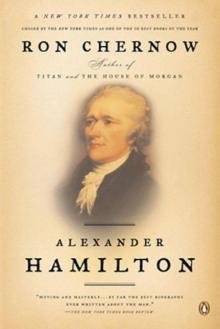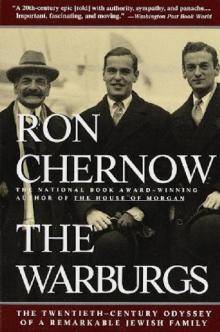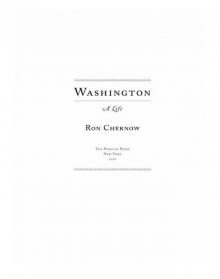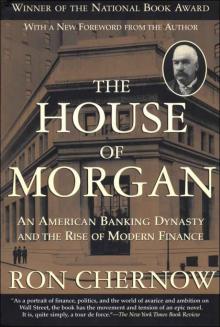- Home
- Ron Chernow
Alexander Hamilton Page 4
Alexander Hamilton Read online
Page 4
That James Hamilton’s career likely lay in ruins before Rachel Faucette Lavien materialized is suggested by the minutes of the St. Kitts Council meeting of July 15, 1748, which reported that he had taken the oath of either a watchman or a weigh man (insects have unfortunately eaten the middle letters) for the port of Basseterre, the island’s capital.26 So if his stint in the tropics was meant to be a fleeting, moneymaking interlude, it had begun to turn into a permanent trap instead. Many young European fortune seekers, expecting to return home, would take a temporary black or mulatto mistress and defer marriage until safely back on native soil. That his plans had drastically miscarried would have made James Hamilton more receptive to a romantic liaison with a separated European woman, now that he knew he was not going to see Scotland again any time soon.
By the time Rachel met James Hamilton for sure in St. Kitts in the early 1750s, a certain symmetry had shaped their lives. They were both scarred by early setbacks, had suffered a vertiginous descent in social standing, and had grappled with the terrors of downward economic mobility. Each would have been excluded from the more rarefied society of the British West Indies and tempted to choose a mate from the limited population of working whites. Their liaison was the sort of match that could easily produce a son hypersensitive about class and status and painfully conscious that social hierarchies ruled the world.
Divorce was a novelty in the eighteenth century. To obtain one in the Crown colonies was an expensive, tortuous affair, and this deprived James and Rachel of any chance to legitimize their match. Putting the best face on the embarrassing situation, Alexander sometimes pretended that his parents had married. Of Rachel’s flight from St. Croix, he declared, “My mother afterwards went to St. Kitts, became acquainted with my father and a marriage between them ensued, followed by many years cohabitation and several children.”27 Since the relationship may have lasted fifteen years, it presumably took on the trappings of a marriage, enabling Alexander to maintain that his illegitimacy was a mere legal technicality and had nothing to do with negligent or profligate parents. Indeed, Hamilton’s parents, though a commonlaw couple, presented themselves as James and Rachel Hamilton. They had two sons: James, Jr., and, two years later, Alexander. (Since Hamilton spoke of his mother’s bearing “several children,” other siblings may have died in childhood.)
The personalities of James and Rachel Hamilton evoked by Alexander’s descendants have a slightly unreal, even sanitized, quality. Hamilton’s own son John conjured up Rachel as “a woman of superior intellect, elevated sentiment, and unusual grace of person and manner. To her he was indebted for his genius.”28 Perhaps no less fanciful was the paternal portrait daubed by Hamilton’s grandson Allan McLane Hamilton: “Hamilton’s father does not appear to have been successful in any pursuit, but in many ways was a great deal of a dreamer, and something of a student, whose chief happiness seemed to be in the society of his beautiful and talented wife, who was in every way intellectually his superior.”29 Is this cozy domestic scene based on credible oral history or family public relations? The documentary record is, alas, mute. The one inescapable impression we have is that Hamilton received his brains and implacable willpower from his mother, not from his errant, indolent father. On the other hand, his father’s Scottish ancestry enabled Alexander to daydream that he was not merely a West Indian outcast, consigned forever to a lowly status, but an aristocrat in disguise, waiting to declare his true identity and act his part on a grander stage.
Few questions bedevil Hamilton biographers more than the baffling matter of his year of birth. For a long time, historians accepted 1757, the year used by Hamilton himself and his family. Yet several cogent pieces of evidence from his Caribbean period have caused many recent historians to opt for 1755. In 1766, Hamilton affixed his signature as the witness to a legal document, a dubious honor if he was only nine. In 1768, a probate court in St. Croix reported his age as thirteen—highly compelling evidence, since it did not rely on his testimony but came from his uncle. When Alexander published a poem in a St. Croix newspaper in 1771, the aspiring bard informed the editor, “Sir, I am a youth about seventeen”—an adolescent’s way of stating that he was sixteen, which would also tally with the 1755 date. The mass of evidence from the period after Hamilton’s arrival in North America does suggest 1757 as his birth year, but, preferring the integrity of contemporary over retrospective evidence, we will opt here for a birthday of January 11, 1755.
From her father, Rachel had inherited a waterfront property on the main street in Charlestown, the Nevis capital, where legend proclaims that Alexander was born and lived as a boy. If so, he would have seen off to the left the town anchorage and a bright expanse of water, crowded with slave and cargo ships; off to the right lay the rugged foothills and dim, brown mountains of St. Kitts. Appropriately enough, this boy destined to be America’s foremost Anglophile entered the world as a British subject, born on a British isle, in the reign of George II. He was slight and thin shouldered and distinctly Scottish in appearance, with a florid complexion, reddishbrown hair, and sparkling violet-blue eyes. One West Indian mentor who remembered Hamilton as bookish and “rather delicate and frail” marveled that he had mustered the later energy for his strenuous American exploits.30 Like everyone in the West Indies, Hamilton had extensive early exposure to blacks. In this highly stratified society, with its many gradations of caste and color, even poor whites owned slaves and hired them out for extra income. In 1756, one year after Hamilton was born, his grandmother, Mary Faucette, now residing on the Dutch island of St. Eustatius, made out her final will and left “my three dear slaves, Rebecca, Flora and Esther” to her daughter Rachel.31
Hamiliton probably did not have formal schooling on Nevis—his illegitimate birth may well have barred him from Anglican instruction—but he seems to have had individual tutoring. His son later related that “rarely as he alluded to his personal history, he mentioned with a smile his having been taught to repeat the Decalogue in Hebrew, at the school of a Jewess, when so small that he was placed standing by her side upon a table.”32 This charming vignette squares with two known facts: elderly women in the Caribbean commonly tutored children, and Nevis had a thriving population of Sephardic Jews, many of whom had escaped persecution in Brazil and entered the local sugar trade. By the 1720s, they constituted one quarter of Charlestown’s white population and created a synagogue, a school, and a well-kept cemetery that survives to this day. His French Huguenot mother may also have instructed Hamilton, for he was comfortably bilingual and later was more at ease in French than Franklin, Adams, Jefferson, and other American diplomats who had spent years struggling to master the tongue in Paris. Perhaps from this exposure at an impressionable age, Hamilton harbored a lifelong reverence for Jews. In later years, he privately jotted on a sheet of paper that the “progress of the Jews ...from their earliest history to the present time has been and is entirely out of the ordinary course of human affairs. Is it not then a fair conclusion that the cause also is an extraordinary one—in other words that it is the effect of some great providential plan?”33 Later on, in the heat of a renowned legal case, Hamilton challenged the opposing counsel: “Why distrust the evidence of the Jews? Discredit them and you destroy the Christian religion....Were not the [Jews] witnesses of that pure and holy, happy and heaven-approved faith, converts to that faith?”34
For a boy with Hamilton’s fertile imagination, Nevis’s short history must have furnished a rich storehouse of material. He was well situated to witness the clash of European powers, with incessant skirmishes among French, Spanish, and English ships and swarms of marauding pirates and privateers. The admiralty court sat in Nevis, which meant that swaggering buccaneers in manacles were dragged into the local courthouse before proper hangings in Gallows Bay. While some pirates were just plain freebooters, many were discreetly backed by warring European nations, perhaps instructing Hamilton in the way that foreign powers can tamper with national sovereignty.
Periodically, cutth
roats came ashore for duels, resorting to conventional pistols or slashing one another with heavy cutlasses—thrilling fare for any boy. Blood feuds were routine affairs in the West Indies. Plantation society was a feudal order, predicated on personal honor and dignity, making duels popular among whites who fancied themselves noblemen. As in the American south, an exaggerated sense of romantic honor may have been an unconscious way for slaveholders to flaunt their moral superiority, purge pent-up guilt, and cloak the brutish nature of their trade.
To the extent that dueling later entranced Hamilton to an unhealthy degree, this fascination may have originated in the most fabled event in Nevis in the 1750s. In 1752, John Barbot, a young Nevis lawyer, and Matthew Mills, a wealthy planter from St. Kitts, were bickering over a land deal when Mills lashed out at Barbot as “an impertinent puppy”—the sort of fighting words that prompted duels.35 One day at dawn, elegantly clad in a silver laced hat and white coat, Barbot was rowed over to St. Kitts by a slave boy. At a dueling ground at Frigate Bay, he encountered Mills, lifted his silver-mounted pistol, and slaughtered him at close range.
At the sensational murder trial, it was alleged that Barbot had gunned down Mills before the latter even had a chance to grab his pistol from his holster. A star witness was Dr. William Hamilton (a possible relation of James Hamilton), who testified that Mills had been shot in the side and therefore must have been ambushed. Certain elements of this trial almost creepily foreshadow the fatal clash between Alexander Hamilton and Aaron Burr. Barbot, well bred yet debt ridden, sneered at the softhearted notion that he had murdered the popular Mills, claiming that he had “killed him fairly according to the notions of honour prevailing among men.”36 Barbot insisted that Mills had aimed his pistol at him even as he absorbed the fatal bullet. As was to happen with Aaron Burr, locals testified that Barbot, in ungentlemanly fashion, had taken target practice in the preceding weeks. Barbot was eventually convicted and packed off to the gallows. Nevis children such as Hamilton, who was born three years later, would have savored every gory detail of this history.
Violence was commonplace in Nevis, as in all the slave-ridden sugar islands. The eight thousand captive blacks easily dwarfed in number the one thousand whites, “a disproportion,” remarked one visitor, “which necessarily converts all such white men as are not exempted by age and decrepitude into a well-regulated militia.”37 Charlestown was a compact town of narrow, crooked lanes and wooden buildings, and Hamilton would regularly have passed the slave-auction blocks at Market Shop and Crosses Alley and beheld barbarous whippings in the public square. The Caribbean sugar economy was a system of inimitable savagery, making the tobacco and cotton plantations of the American south seem almost genteel by comparison. The mortality rate of slaves hacking away at sugarcane under a pitiless tropical sun was simply staggering: three out of five died within five years of arrival, and slave owners needed to replenish their fields constantly with fresh victims. One Nevis planter, Edward Huggins, set a sinister record when he administered 365 lashes to a male slave and 292 to a female. Evidently unfazed by this sadism, a local jury acquitted him of all wrongdoing. A decorous British lady who visited St. Kitts stared aghast at naked male and female slaves being driven along dusty roads by overseers who flogged them at regular intervals, as if they needed steady reminders of their servitude: “Every ten Negroes have a driver who walks behind them, holding in his hand a short whip and a long one... and you constantly observe where the application has been made.”38 Another British visitor said that “if a white man kills a black, he cannot be tried for his life for the murder....If a negro strikes a white man, he is punished with the loss of his hand and, if he should draw blood, with death.”39 Island life contained enough bloodcurdling scenes to darken Hamilton’s vision for life, instilling an ineradicable pessimism about human nature that infused all his writing.
All of the horror was mingled incongruously with the natural beauty of turquoise waters, flaming sunsets, and languid palm fronds. In this geologically active zone, the hills bubbled with high-sulfur hot springs that later became tourist meccas. The sea teemed with lobster, snapper, grouper, and conch, while the jungles were alive with parrots and mongooses. There were also monkeys galore, green vervets shipped from Africa earlier in the century. Many travelers prized the island as a secluded refuge, one finding it so “captivating” that he contended that if a man came there with his wife, he might linger forever in the “sweet recess” of Nevis.40 It was all very pleasant and balmy, supremely beautiful and languid, if you were white, were rich, and turned a blind eye to the black population expiring in the canebrakes.
If Rachel thought that Johann Michael Lavien’s appetite for revenge had been sated in Christiansted, she was sadly disabused of this notion in 1759. Nine years after Rachel had fled St. Croix, Lavien surfaced for one final lesson in retribution. Oppressed by debt, he had been forced to cede his most recent plantation to two Jewish moneylenders and support himself as a plantation overseer while renting out his little clutch of slaves. In the interim, he had begun living with a woman who took in washing to boost their income. It may have been Lavien’s wish to marry this woman that abruptly prompted him to obtain an official divorce summons from Rachel on February 26, 1759.
In a document seething with outrage, Lavien branded Rachel a scarlet woman, given to a sinful life. Having failed to mend her ways after imprisonment, the decree stated, Rachel had “absented herself from [Lavien] for nine years and gone elsewhere, where she has begotten several illegitimate children, so that such action is believed to be more than sufficient for him to obtain a divorce from her.”41 Lavien noted bitterly that he himself “had taken care of Rachel’s legitimate child from what little he has been able to earn,” whereas she had “completely forgotten her duty and let husband and child alone and instead given herself up to whoring with everyone, which things the plaintiff says are so well known that her own family and friends must hate her for it.”42 After this vicious indictment, Lavien demanded that Rachel be denied all legal rights to his property. He warned that if he died before her, Rachel “as a widow would possibly seek to take possession of the estate and therefore not only acquire what she ought not to have but also take this away from his child and give it to her whore-children.”43 This was how Lavien designated Alexander and his brother: whore-children. He was determined to preserve his wealth for his one legitimate son, thirteen-year-old Peter.
Rachel was undoubtedly stunned by this unforeseen vendetta, this throwback to a nightmarish past. Summoned to appear in court in St. Croix, she must have feared further reprisals from Lavien and did not show up or refute the allegations. On June 25, Lavien received a divorce that permitted him to remarry, while Rachel was strictly prohibited from doing so. The Danish authorities took such decrees seriously and fined or dismissed any clergyman who married couples in defiance of such decisions. In one swiftly effective stroke, Lavien had safeguarded his son’s inheritance and penalized Rachel, making it impossible for her two innocent sons ever to mitigate the stigma of illegitimacy. However detestable Lavien’s actions, two things should be said in his defense. Rachel had relinquished responsibility for Peter and forced Lavien to bring the boy up alone. Also, Lavien subsequently witnessed legal documents for the Lyttons, Rachel’s St. Croix in-laws, suggesting that her own family may have seen her life as less than blameless.
In view of this lacerating history, Rachel probably never imagined that she would return to St. Croix, but a confluence of events changed that. In the early 1760s, Lavien moved to Frederiksted, on the far side of St. Croix from Christiansted, and dabbled in real estate. Then, around 1764, Peter moved to South Carolina. So when James Hamilton received a business assignment in Christiansted in April 1765, he could have taken along Rachel and the two boys without fearing any untoward collisions with Lavien. James Hamilton had continued to feed off his brother’s Glasgow business connections. He served as head clerk for Archibald Ingram of St. Kitts, the son of a Glasgow “tobacco lord” of the s
ame name. The Ingrams asked James to collect a large debt due from a man named Alexander Moir, who was returning to Europe and denied owing them money; the resulting lawsuit was to drone on until January 1766. In the meantime, Rachel and the boys took up residence in Christiansted. Thrust back into the world of her former disgrace, Rachel lived blocks from the fort where she had been jailed and no longer had the liberty of posing as “Mrs. Hamilton.” (On the St. Croix tax rolls, she shows up under misspelled variants of Faucette and Lavien.) Stripped of whatever cover of legitimacy had sheltered them, it would have become glaringly evident to Alexander and James, Jr., for the first time that they were “natural” children and that their mother had been a notorious woman.
James Hamilton scored an apparent victory in the Moir case, then left St. Croix and deserted his family forever. Why this sudden exit? Did Rachel’s scandalous reputation cause a rift in their relationship? Did Lavien conduct a smear campaign and poison the air with innuendo? These scenarios seem unlikely given that James Hamilton never appeared on the St. Croix tax rolls, suggesting that he knew all along that he was a transient visitor. Alexander offered a forgiving but plausible reason for his father’s desertion: he could no longer afford to support his family. Because James, Jr., twelve, and Alexander, ten, had attained an age where they could assist Rachel, James, Sr., may have believed that he could wash his hands of paternal duties without undue pangs of guilt. More in sorrow than malice, Alexander wrote a Scottish kinsman thirty years later, “You no doubt have understood that my father’s affairs at a very early day went to wreck, so as to have rendered his situation during the greatest part of his life far from eligible. This state of things occasioned a separation between him and me, when I was very young.”44 Alexander probably never set eyes again on his vagabond father, who stayed in the Caribbean, either lured by the indolent tropic tempo or ground down by poverty. Father and son never entirely lost touch with each other, but a curious detachment, an estrangement as much psychological as geographical, separated them. As we shall see, there is a possible reason why James Hamilton may have felt less than paternal toward his son and Alexander less than filial toward him.

 Alexander Hamilton
Alexander Hamilton The Warburgs
The Warburgs Titan
Titan Grant
Grant Washington
Washington The House of Morgan
The House of Morgan The House of Morgan: An American Banking Dynasty and the Rise of Modern Finance
The House of Morgan: An American Banking Dynasty and the Rise of Modern Finance